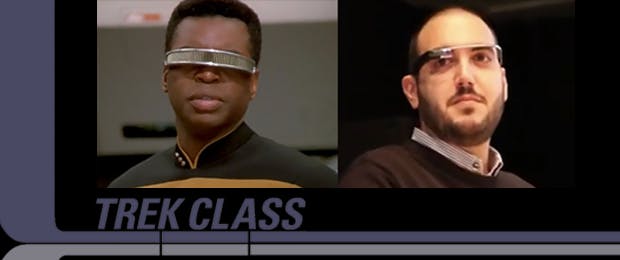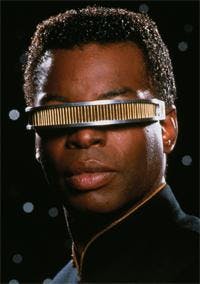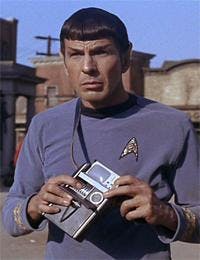Published Jan 19, 2014
TREK CLASS: Future Vision - The Tech of Trek
TREK CLASS: Future Vision - The Tech of Trek

One of the best things about teaching Trek Class is hearing from students about how Star Trek has influenced or inspired them. Many times these are stories of technology and exploration, but often Star Trek fans are equally inspired by the very human aspects that come along with its famous future technologies.

Star Trek technologies often seem very real to us because they are more than exciting gadgets used to dress up the futuristic scenery. For Gene Roddenberry and the writers of Star Trek, the technology of the 23rd and 24th Centuries offered another, subtle way to show us the possibilities of human achievement and how technology can be used to improve our quality of life. The VISOR, for example. gives LaForge not only sight, but the ability to see a spectrum his normal-sighted shipmates cannot. Perhaps to the credit of Levar Burton’s performance, as well as the writing, we can truly believe that this wearable device isn’t far off in our own future.

But the early 21st Century is a great time to be a Star Trek fan — our world is suddenly starting to look just a little bit like the Final Frontier! I almost envy the students who are experiencing the shows for the first time in my class this semester. They are able to look around and see the earliest steps toward Star Trek’s once-astonishing concepts in the form of real-life products and breakthroughs, many of which have been directly inspired by the series.
For example, that tricorder — Star Trek’s ubiquitous scanning device — has long been the dream of scientists and engineers, and pretty much anyone else who has ever had to measure or collect information about something. Today, the tricorder is a very real (albeit very basic) device called the Scandu Scout that can read a person’s vital signs in seconds and send them instantly to a mobile phone. Similarly, sensors are showing up everywhere — in our mobile phones (there are at least five different types of sensors in an iPhone) and other consumer electronics. These devices, along with wristbands, “smart watches" and other trackers, are part of the “quantified self” trend that has some people already monitoring their own biometric data - from . like activity to nutrition and even sleep quality — as if they had access to the sick bay computers.
Those who have been following Trek Class also know about our discussion of the replicator, which is slowly becoming a reality through 3D Printers. These machines can form objects on-demand (from plastic, not molecules) and are quickly becoming one of the hottest new areas in the tech industry. They have already been used to print prosthetic ears and hands, toys, machine parts and even (unfortunately) weapons. And if the replicator seems like an impossible dream starting to come true, what about the holodeck? You might be enjoying a very early holo-novel soon enough as technologies like the Oculus Rift virtual reality device continue to evolve.
In a recent experiment, I taught a class while wearing Google Glass — the VISOR-like device that projects information onto a tiny screen in front of your eye. With the help of a special app, I was able to receive messages from my class Twitter feed while I was teaching. It was a little distracting at first (ok, very distracting), but after a few minutes I found it very helpful to see the students reactions to my lecture in real-time. Happily, the experiment led us to many new ideas about how a technology like this could be used to enhance our everyday lives, including how we learn at school, which will guide the next steps of this project.
We have a long, long way to go before we reach the technical capabilities of the VISOR, or just about any gadget on the U.S.S Enterprise. These few examples are just a small sample of the rapidly emerging technologies that are bringing us ever closer to that day. As I think of the student who was inspired by Geordi and his VISOR, and then the engineers at Google and around the world who are just now taking the first steps toward making that a reality, I am reminded of the important role Star Trek has played in the process by inspiring curiosity around technology and science of all kinds. Star Trek continues to have this effect on viewers today, including those seeing it for first time in my class.
______________
Anthony Rotolo is a professor at Syracuse University, where he teaches “Trek Class.” He is also the founder and “Captain” of the “Starship NEXIS,” a lab that explores new and emerging technologies.
